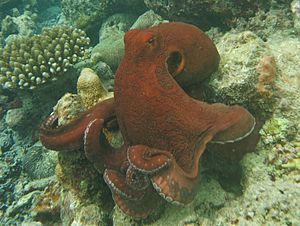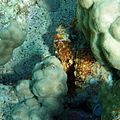Big blue octopus facts for kids
Quick facts for kids Big blue octopus |
|
|---|---|
 |
|
| Scientific classification | |
| Genus: |
Octopus
|
| Species: |
cyanea
|
| Synonyms | |
|
|
The Octopus cyanea, also known as the big blue octopus or day octopus, is a fascinating sea creature. It belongs to the family Octopodidae. You can find this octopus in both the Pacific and Indian Oceans. Its home ranges from Hawaii all the way to the eastern coast of Africa.
This octopus can grow quite large. Its main body, called the mantle, can be up to 16 cm long. Its arms can stretch out to at least 80 cm! The big blue octopus was first described by a British zoologist named John Edward Gray in 1849. The first specimen studied was found near Australia. It is now kept at the Natural History Museum in London.
Contents
Amazing Camouflage Skills
The big blue octopus lives on coral reefs and hunts during the day. This means it needs to be very good at hiding! It is a master of camouflage. This octopus can change its color, patterns, and even the texture of its skin very quickly.
One scientist watched an O. cyanea change its look 1000 times in just seven hours. As it moves across the seabed, it instantly changes its colors and patterns. This helps it match the rocks or sand below. These quick color changes happen because of special cells called chromatophores. The octopus's brain controls these cells directly.
Sometimes, when it's near prey like a crab, the octopus will create a "passing clouds" display. This makes it look like a dark shadow is moving over its body. This trick might make the crab move without thinking, making it easier for the octopus to catch.
Where the Big Blue Octopus Lives
The O. cyanea lives in the Indo-Pacific region. You can find it on reefs and in shallow waters. Its range includes the Red Sea, the East African coast, and Madagascar. It also lives in southeastern Asia, Oceania, and as far away as Hawaii.
Life on the Reef
Daily Habits
Most octopuses are active at night. However, the big blue octopus is different. It is a diurnal animal, meaning it's active during the day. It is most active at dawn and dusk, which is called being crepuscular.
This octopus always has a home, called a den. It returns to this den after it finishes hunting for food. Its den might be a crack in a rock, a hidden spot under an overhang, or a safe place among coral. It can even dig a hole in sand or rubble to make a home.
What They Eat
The big blue octopus is a predator. It actively searches the reef for its meals. It loves to eat fish, crabs, shrimp, and other molluscs. If the food item is small, the octopus might eat it right where it catches it. But if it's a bigger meal, it will carry it back to its den to eat.
When it catches a crab, the octopus might bite it and inject a special, mild toxin. Then, it uses its beak-like mouth to chew up the crab. For molluscs, it can drill a small hole in their shells. This helps it get to the soft animal inside. After eating, the octopus discards empty mollusc shells and crab carapaces outside its den. These piles of leftovers are called a midden.
Sometimes, these clever octopuses even hunt together with other fish. They have been seen working with the roving coral grouper to catch food.
Lifespan and Growth
The big blue octopus usually lives for about 12 to 15 months. This is after it grows from a tiny planktonic larva. During its life, it grows a lot! It can go from about 67 grams (a little over 2 ounces) to 6500 grams (about 14 pounds). It grows very quickly, turning more than half of the food it eats into new body mass. This growth relies heavily on protein from its prey.
In aquariums, these octopuses can breed at any time of the year. This probably depends on when the female is ready to lay eggs. The male octopus might mate with several different females. After mating, the suckers on the edge of the male's webbing get much bigger. Over the next two to three months, these suckers keep growing, and the male octopus slowly declines and dies. The female octopus stays with her eggs in the den. She protects them until they hatch, and then she also dies shortly after.
Images for kids
See also
 In Spanish: Pulpo del día para niños
In Spanish: Pulpo del día para niños



